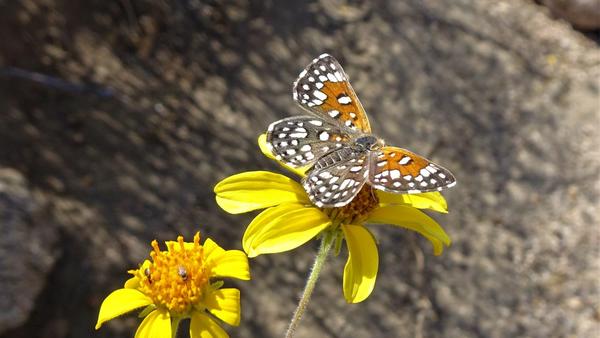Chasing Butterflies
“’Just living isn’t enough,’ said the butterfly, ‘one must have sunshine, freedom and a little flower.’” — Hans Christian Anderson
Faced with the immense diversity of life, scientists and naturalists often specialize in one or maybe two groups to be able to name, and so understand, even a small fraction of that diversity. Scientists studying birds are called ornithologists and when they along with other naturalists are watching birds it is called “birding." Scientists who study reptiles and amphibians are referred to as herpetologists, and when they and other naturalists are on a quest for finding their preferred species they are “herping." When naturalists, plant ecologists, and taxonomists are out in search of plants, it is called "botanizing." Those who study butterflies are called lepidopterists, and when in pursuit of those beautiful, diaphanous-winged beasts it is called "butterflying."
I admit that I am a novice when it comes to butterflying. There are close to 135 butterfly species in our region; 90 have been detected in Joshua Tree National Park. That is a lot. There are “just” 33 species of lizards, and about 27 snake species. Still, 90 or even 135 is a tractable number, one that with some effort a person could get to know many if not most of the butterflies of our region.
One of my first encounters with “butterfly naturalists” was while exploring tropical forests in the Amazon Basin. Rather than in the open desert where one can hang out near plants in bloom and see many of the local butterflies, in the Amazon the flowers are at the tops of trees, 100-200 feet above your head. Yet the butterfly enthusiasts have a trick for luring their quarry to the forest floor: each of those butterfly chasers has developed their own secret “recipe” for attracting butterflies, a mixture of rotten bananas, fruit juice, feces, and urine. It turns out that the nitrogen, ammonia, and salt in feces and urine can be in short supply in the tropics, but they are essential for the metabolism of life; butterflies crave those minerals. The lepidopterists set out piles of their “secret sauce” in forest gaps and then wait for the butterflies to arrive. I was told it was impolite to ask whose feces and urine they were using.
There is incredible butterfly diversity here, despite desert heat and aridity. Why so many species? A big part of the answer to that question is because butterflies are specialists. Not so much on the flowers they drink nectar from, and for which the butterflies become important pollinators, but their specialization comes in when looking for which plants to lay their eggs and then grow their caterpillars on. Most of us are aware that Monarchs, and their cousins the Desert Queens, exclusively lay their eggs on highly toxic members of the milkweed family. The caterpillars incorporate those toxins into their bodies and into the bodies and wings of their future self, providing them a chemical defense from predators and parasites. For other butterfly species, even if their host plant (the plant that they lay eggs on and on which their caterpillars feed) is not toxic, they are often uncommon. One of the threats to the ability of a caterpillar growing and pupating and becoming a butterfly is from parasites, wasps and other insects that lay their eggs on caterpillars and their young then eat the caterpillar. By the diversifying of butterflies, specializing on often rare host plants, the parasitic wasps have a tougher time developing a single search image on how to find caterpillars, and so more caterpillars survive. To attract butterflies to your yard, you need to know their food plants and then plant those along with nectar-producing flowers. One of the aspects of butterflying that attracts me is this clear connection between butterflies and their host plants, the connection between the animal and plant. Seasoned butterfly enthusiasts link up the adult butterflies and their host plants so that they make the ecological relationships that are so critical to understanding nature.
The other thing that attracts me is the evocative common names that are applied to these beautiful animals. “Sleepy Orange,” “Great Purple Hairstreak,” “Sagebrush Checkerspot," “Painted Lady," “California Sister." The list of course goes on and on. No less beautiful, but bird names are pedestrian by comparison: “Black-throated Sparrow,” “Cactus Wren,” “Mockingbird,” and Red-tailed Hawk” all pale in contrast. Lizard common names, it pains me to say, are no better: “Side-blotched Lizard," “Western Fence Lizard” or “Banded Gecko." However, I will say that a “Chuckwalla” (a Cahuilla name) and a “Gila Monster” compare more favorably with those butterfly appellations.
Being a naturalist goes hand in hand with a lifelong thirst for knowledge about the natural world around us, and for me beginning a journey of butterflying is one more way to quench that thirst.
Nullius in verba
Go outside, tip your hat to a chuckwalla (and a cactus), think like a mountain, and be safe.
